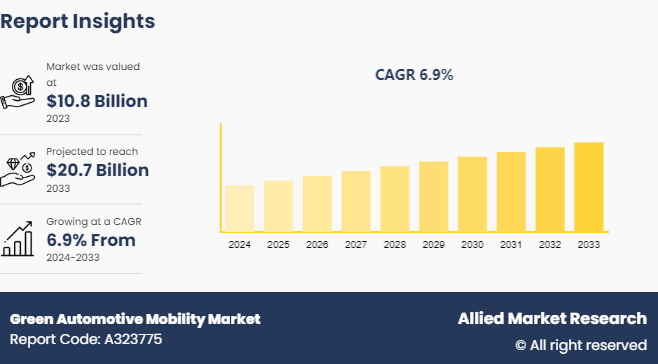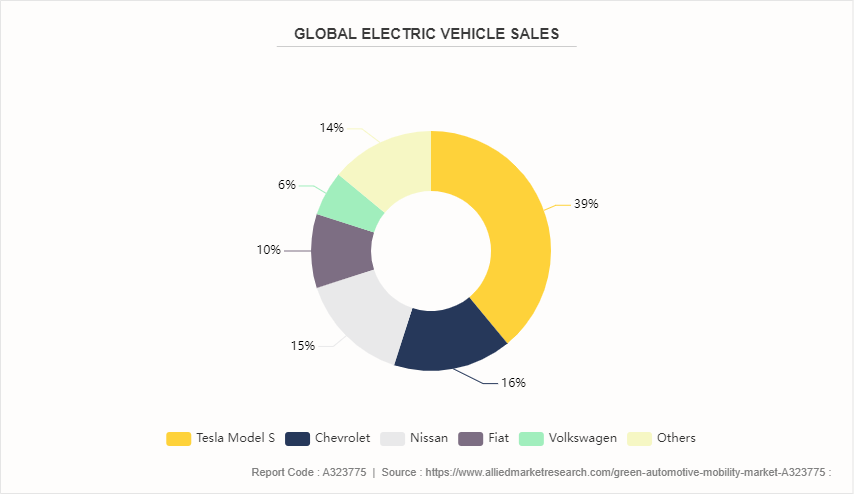Green Automotive Mobility Market Research, 2033
The global green automotive mobility market was valued at $10.8 billion in 2023, and is projected to reach $20.7 billion by 2033, growing at a CAGR of 6.9% from 2024 to 2033.

Market Introduction and Definition
The green automotive mobility industry involves the sector of the automotive industry that is focused on the development, production, and sale of vehicles and related technologies that reduces environmental impact. The market also includes different types of vehicles and mobility solutions that help in emphasizing the importance of sustainability, reduced carbon emissions, and energy efficiency.
Increasing penetration on battery electric vehicles, plug-in hybrid electric vehicles, hybrid electric vehicles, hydrogen fuel cell vehicles, alternative fuel vehicles, autonomous vehicles, and shared mobility solutions demonstrate the shift toward sustainable practices among consumers.
Key Takeaways
The green automotive mobility market study covers 20 countries. The research includes a segment analysis of each country in terms of value ($billion) for the projected period 2024-2033.
More than 1,500 product literature, industry releases, annual reports, and other such documents of major green automotive mobility industry participants along with authentic industry journals, trade associations' releases, and government websites have been reviewed for generating high-value industry insights.
The study integrates high-quality data, professional opinions and analysis, and critical independent perspectives. The research approach is intended to provide a balanced view of global markets and to assist stakeholders in making educated decisions to achieve their most ambitious growth objectives.
Key Strategies and Developments
The Future Mobility Development Center (FMDC) , a new test facility for completely automated development and test drives, was launched by the BMW Group in July 2023. The FMDE is located in Sokolov, Czechia (Czech Republic) . The BMW Group invested €300 million in, the building of an FMDC facility in Central Europe. The new test establishment follows a sustainable environmental protocol and provides a platform for the testing of advanced technology. This strategic move will strengthen the position of BMW in the green automotive mobility sector and will also boost the growth of the green automotive mobility market size.
In February 2024, Uber launched a flagship electric vehicle service called Uber Green in Delhi to enable people to book sustainable, eco-friendly rides in the application. The riders can now identify uber-green options to book a green eco-friendly ride. The service will help in promoting the use of EVs, thus supporting sustainable travel means. This strategic move will strengthen Uber’s position in the green automotive mobility market size.
In April 2024, Ather Energy, an Indian EV automotive manufacturer and provider, launched a family scooter, Ritza. The scooter price starts at 1.09 lakh rupees. The scooter will be available in two models, Rizta S, and Rizta Z. The vehicles contain a battery capacity of 2.9 kilowatt hours (kWH) , as the most expensive variant of the EV model comes with a battery of 3.7 kWH. The 2.9 kWh variants will deliver a predicted Indian driving conditions (IDC) range of 123 km, while the 3.7 kWH vehicle will deliver 160 km. This strategic move will strengthen the position of Ather Energy in the global green automotive mobility market and will help in increasing its green automotive mobility market share.
In March 2024, Tata Motors launched next-generation, green-fuel-powered commercial vehicles to Tata Steel. The fleet includes Prima tractors, tippers, and the Ultra EV bus, powered by Liquefied Natural Gas (LNG) and battery electric technologies. Tata Motors new-age fleet of commercial vehicles comes equipped with multiple safety features including advanced driver assistance system (ADAS) , Electronic Stability Control, Active Traction Control, and Driver Monitoring System, amongst others. The vehicles were handed over to Tata Steel’s delivery partners for transporting steel products and raw materials. This strategic move will increase green automotive mobility market growth.
Key Market Dynamics
Increasing concern for the environment, decrease in price of electric vehicles, and rise in fuel cost are the primary factors driving the growth of global green automotive mobility market. Emission regulations are being set by different associations and organizations in different regions to encourage automotive manufacturers to produce increasing units of electric vehicles. Furthermore, governments are offering incentives such as tax credits, rebates, and subsidies for the purchase of EVs, thus making it a more affordable alternative for users. Lack of electricity power infrastructure to support electricity vehicle fuel requirements is a significant factor that can hold the growth of the green automotive mobility market in the future. The government along with private sectors need to invest more heavily in the setting up of more electric vehicle (EV) stations and establishment of large power girds to meet the growing demand for electricity and to support the adoption of EVs. Utilization of renewable energy sources, to generate electricity and integration of smart features in electric vehicles are the significant factors that will drive the growth of green automotive mobility market opportunity.
Market Segmentation
The global green automotive mobility market is segmented into type, vehicle type, and region. Depending on type, the global green automotive mobility market is divided into battery electric vehicles, hybrid electric vehicles, plug-in hybrid electric vehicles, fuel cell electric vehicles, and others. On the basis of vehicle type, the global green automotive mobility market is divided into 2-wheeler vehicles, 3-wheeler vehicles, 4-wheeler vehicles, and other commercial vehicles. Region wise, the global green automotive mobility market is analyzed across North America, Europe, Asia-Pacific, Latin America, and Middle East & Africa.

Region and Country Developments
As per International Energy Agency, around 10 million electric car units were sold in 2022 on a global level. In 2021 around 6.9 million units of electric car were sold. The countries that sold the largest share of vehicles were China, Europe, and the U.S.
India sold 12, 43, 258 units of EVs in 2022, a 154% increase over the sales of 2021, with two-wheeler EVs accounting for most of the sales.
As per Hitachi, analysts have predicted that over 100 million electric vehicles will be available on the road by 2030 in North America.
The federal government in the U.S. and Canada are funding the transformation towards a strong sustainable infrastructure in North America that involves increasing funding for mass changes. The American Government job plan policy is aiming to create a carbon pollution-free sector by 2035 and achieve net-zero emission economy by 2050.
As per Xinhua, a Chinese news agency, data gathered from the China Association of Automobile Manufacturers shows that exports by China’s new energy vehicles include both sales of pure electric and hybrid vehicles up- to 1.2 million units in 2023.
BYD, a Chinese electric vehicle brand was the world’s largest EV manufacturer in the quarter of 2023.
As per Basf, a chemical company source, it has been stated in the mid and long development plan for automotive industry that by the year 2020, NEV sales will hit 2 million and by 2025 over 20% car sales will be powered by new energy source in China.
Competitive Analysis
The major players operating in the green automotive mobility market include BMW, BYD, Tesla, Daimler AG, Nissan, Engie, Ford, Kia Motors, and Uber. The following players adopted product launch, service launch, and facility launch strategies to increase their market share in the global green automotive mobility market.
The other players in the industry include General Motors, Volkswagen, Hyundai Motor Company, Maruti, Tata Motors Limited, Toyota, and Volvo Car Corporation.
Industry Trends
Battery electric vehicles are dominating the green automotive mobility market. However, hybrid EVs are expected to witness rapid penetration at a rapid pace in the green automotive mobility market forecast, as they involve the combination of electric power and conventional engines.
E-bikes and e-scooter are witnessing growing adoption in the green automotive mobility market.
Development of transport modes & systems and increase in smart city initiatives are accelerating the trend of mobility-as-a-service (MaaS) .
Artificial Intelligence (AI) technology is heavily influencing green automotive mobility market. Features such as autonomous driving, predictive maintenance, and traffic management, digitally mapped streets, and AI driven traffic solutions are being integrated with electric vehicles (EVs) .
The green automotive mobility market is highly competitive in nature and include large major players such as Tesla, BYD, BMW, and Nissan. The major players are heavily investing in advanced technologies and are expanding their product lines. New companies from China and India are also releasing many EVs and increasing the competition in the green automotive mobility market. As per OICA website China and India produced 30, 160, 966 and 5, 851, 507 vehicle units respectively in 2023
Innovations in battery technology, such as solid-state batteries and increased energy density, are extending the range and reducing the cost of electric vehicles. For instance, in 2024, Saft, a French battery manufacturing company launched three innovative battery technologies namely new-gen lithium ion-batteries, lithium-sulfur batteries, and solid-state batteries.
In addition, investment in charging infrastructure is increasing globally, addressing range anxiety and facilitating EV adoption. As per IEA the global number of public charging points exceeds 15 million by 2030, up four-fold compared to the almost 4 million operating in 2023. By 2035, this number reaches almost 25 million in the APS, a sixfold increase relative to 2023.
Key Sources Referred
HITACHI
XINHUA
Tata Motors Press Release
Volkswagen Group Press Release
Globe News Wire
Green Car Congress
Economic Times
OICA
IEA
BASF
BMW Group Press Release
Key Benefits For Stakeholders
- This report provides a quantitative analysis of the market segments, current trends, estimations, and dynamics of the green automotive mobility market analysis from 2024 to 2033 to identify the prevailing green automotive mobility market opportunities.
- The market research is offered along with information related to key drivers, restraints, and opportunities.
- Porter's five forces analysis highlights the potency of buyers and suppliers to enable stakeholders make profit-oriented business decisions and strengthen their supplier-buyer network.
- In-depth analysis of the green automotive mobility market segmentation assists to determine the prevailing market opportunities.
- Major countries in each region are mapped according to their revenue contribution to the global market.
- Market player positioning facilitates benchmarking and provides a clear understanding of the present position of the market players.
- The report includes the analysis of the regional as well as global green automotive mobility market trends, key players, market segments, application areas, and market growth strategies.
Green Automotive Mobility Market Report Highlights
| Aspects | Details |
| Market Size By 2033 | USD 20.7 Billion |
| Growth Rate | CAGR of 6.9% |
| Forecast period | 2024 - 2033 |
| Report Pages | 250 |
| By Type |
|
| By Vehicle Type |
|
| By Region |
|
| Key Market Players | Volkswagen, Tesla, Ford, Volvo Car Corporation, BMW, Engie, Maruti Suzuki India Limited, Nissan, Tata Motors Limited, Kia Motors, Daimler AG, General Motors, BYD, Uber, Hyundai Motor Company, Toyota |
Battery electric vehicles are dominating the green automotive mobility market. However, hybrid EVs are expected to witness rapid penetration at a rapid pace in the future, as they involve the combination of electric power and conventional engines.
The battery electric vehicle segment dominated the green automotive mobility market due to improvements in battery technology and initiatives by the government.
Asia-Pacific is the largest regional market for Green Automotive Mobility.
$20.7 Billion is the estimated industry size of Green Automotive Mobility.
BMW BYD, Tesla, Daimler AG, Nissan, Engie, Ford, Kia Motors, Uber, General Motors, Volkswagen, Hyundai Motor Company, Maruti, Tata Motors Limited, Toyota, and Volvo Car Corporation.
Loading Table Of Content...



